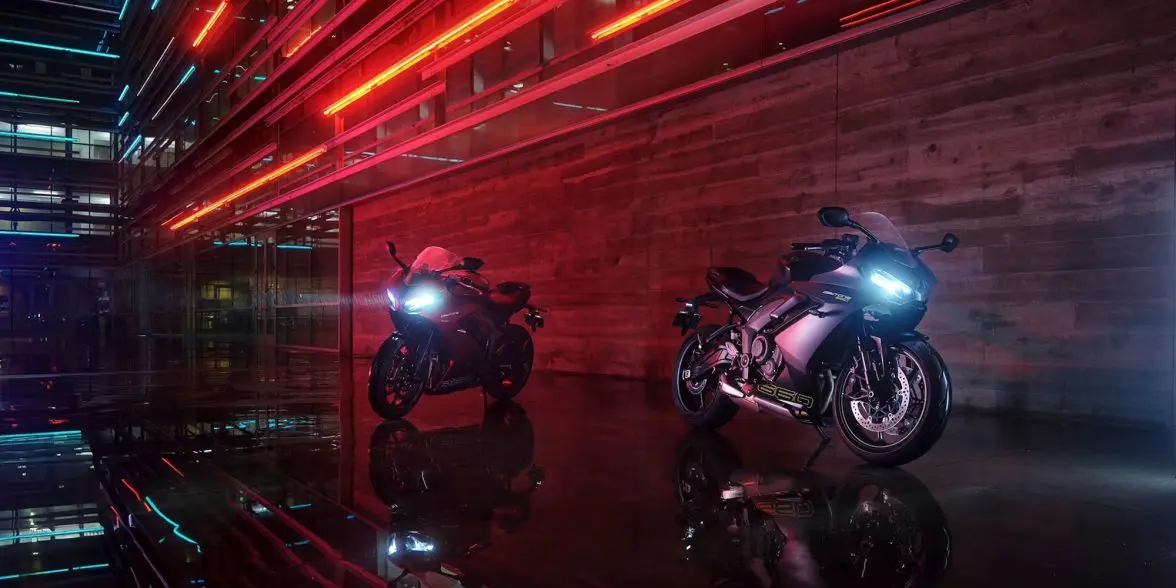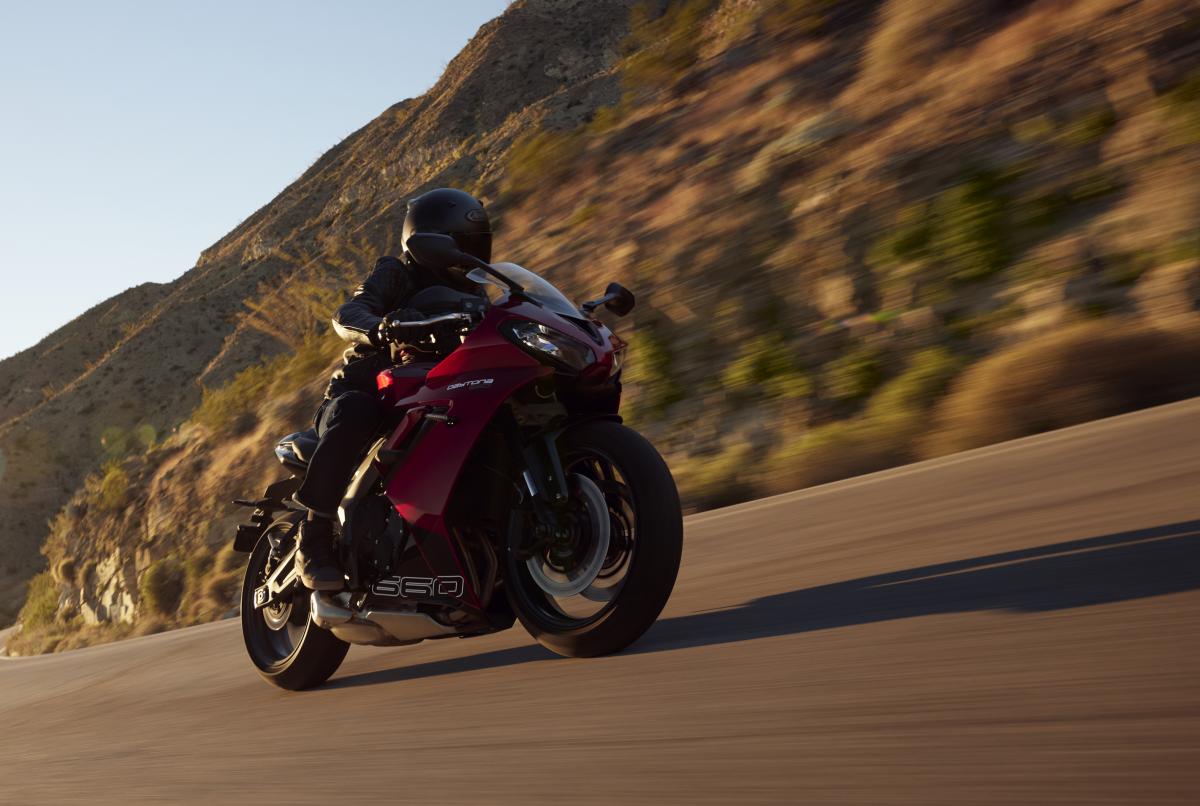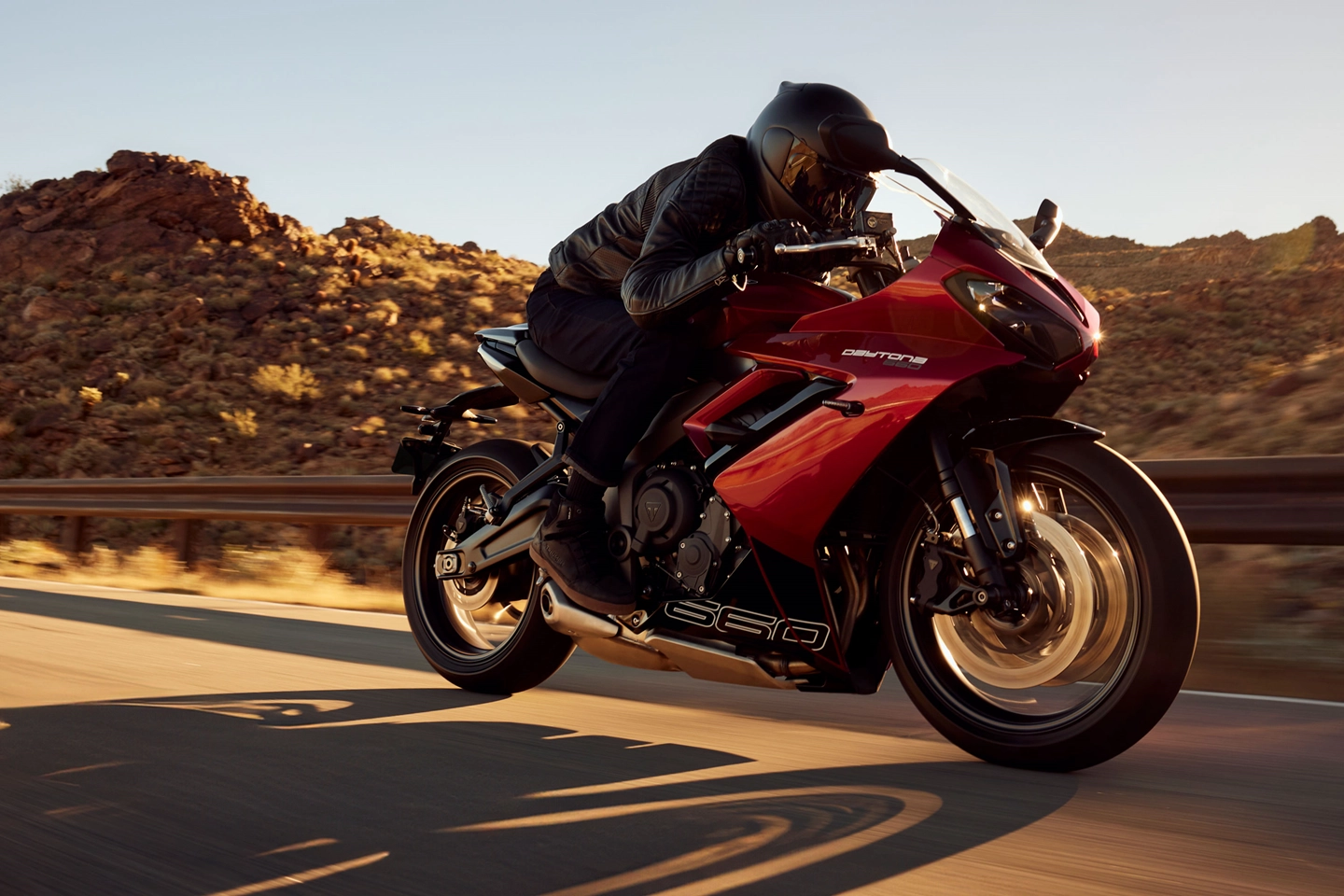Triumph has unveiled a brand-new middleweight sports bike with triple power for the year 2024. The Daytona 660 promises an exhilarating sports performance, dynamic riding experience, and top-tier quality, capability, and specifications within its class.
The motorcycle boasts a significant evolution of Triumph’s distinct 660cc triple engine, now delivering 95PS peak power and 69Nm of peak torque. This engine ensures a smooth, responsive, and linear delivery, featuring a perfect blend of low-down torque, mid-range power, and top-end performance. In comparison to the Trident, the Daytona 660 provides 17% more power and 9% more torque, accompanied by a new exhaust system that produces a distinctive sports soundtrack.

The Daytona 660’s well-balanced chassis, combined with intuitive and agile sports handling, offers all-day riding comfort. High-spec equipment, including Showa upside-down big piston 41mm forks and a Showa preload-adjustable Mono shock RSU, contributes to this comfort. The motorcycle is equipped with radial four-piston brakes, twin 310mm discs, braided brake lines, and Michelin’s new Power 6 tires.
With a seat height of 810mm, narrow stand-over, and optimized bar and footpeg positions, the Daytona 660 ensures an exciting and confidence-inspiring ride. Rider-focused technology includes three riding modes (Sport, Road, and Rain) that optimize throttle response and traction control settings, along with an Emergency Deceleration Warning system.
The unmistakable Daytona design DNA has been reimagined for an aggressive stance, featuring twin LED headlights with a central air intake, minimal bodywork emphasizing an athletic profile, and a contoured LED taillight. Three striking color options, each featuring a bold ‘660’ race-inspired graphic, are available.

As expected from Triumph, the Daytona comes with over 30 Genuine Triumph Accessories, allowing riders to tailor performance, comfort, style, and practicality. These include an A2 license kit for restricted power, offering a dedicated throttle twist grip and engine tune limiting power to 35kW.
With a 10,000-mile service interval, a two-year unlimited mileage warranty, and strong residual values, the Daytona 660 aims to offer a competitive cost of ownership. Triumph’s Chief Product Officer, Steve Sargent, expressed excitement about the impact the Daytona 660 will have on the growing middleweight sports world.
THRILLING SPORTS PERFORMANCE The Daytona’s triple engine delivers 95PS at 11,250rpm, with a hair-raising 12,650rpm redline. More than 80 percent of the peak torque of 69Nm is available from just 3,125rpm, providing responsive and fully usable performance. The unique triple soundtrack is further enhanced by the new exhaust system.
AGILE, DYNAMIC RIDE Benefiting from race-winning chassis development, the Daytona 660 features a lightweight sports frame, top-quality Showa suspension, lightweight cast aluminum wheels, and Michelin Power 6 tires. The braking system, with twin four-piston radial calipers, offers excellent stopping power.

RIDER-FOCUSED TECHNOLOGY The ride-by-wire throttle allows for three riding modes (Sport, Road, and Rain), optimizing throttle response and traction control. The multi-functional instruments include a color TFT screen compatible with the My Triumph Connectivity System for navigation and phone and music interaction.
CONTROL & COMFORT With a natural riding position, comfortable controls, and light steering, the Daytona 660 provides superb control in various environments. The motorcycle features split rider and pillion seats, with the option of an accessory low seat for further customization.
MAKE THE DAYTONA 660 YOUR OWN Over 30 Genuine Triumph Accessories are available, including color-coded seat cowl, billet-machined parts, My Triumph Connectivity System, Triumph Shift Assist, heated grips, USB socket, tyre pressure monitoring system (TPMS), tank bag, and tail pack. New security accessories, like the Triumph Protect+ alarm system and Triumph Track+ tracker, enhance the Daytona 660’s appeal.
ON THE ROAD The Daytona 660 starts at £8,595 OTR, and more information can be found at triumphmotorcycles.co.uk or through local Triumph dealers, with bikes arriving in dealerships from the end of March 2024.
SPECIFICATIONS
ENGINE AND TRANSMISSION
| Type | Liquid cooled, inline 3-cylinder,12 valve, DOHC, 240° Firing order. | |
| Capacity | 660cc | |
| Bore | 74.04mm | |
| Stroke | 51.1mm | |
| Compression | 12.05:1 | |
| Maximum Power | 70 kW (95PS) at 11,250 rpm | |
| Maximum Torque | 69 Nm @ 8,250 rpm | |
| Fuel System | Multipoint sequential electronic fuel injection with electronic throttle control | |
| Exhaust | Stainless steel 3 into 1 header system with low single sided stainless-steel silencer | |
| Final Drive | X-ring chain | |
| Clutch | Wet, multi-plate, slip & assist. | |
| Gearbox | 6 speeds |
CHASSIS
| Frame | Tubular steel perimeter frame | |
| Swingarm | Twin-sided, fabricated steel | |
| Front Wheel | Cast aluminum alloy 5 spoke, 17 x 3.5 in | |
| Rear Wheel | Cast aluminum alloy 5 spoke, 17 x 5.5 in | |
| Front Tyre | 120/70 ZR 17 | |
| Rear Tyre | 180/55 ZR 17 | |
| Front Suspension | Showa 41mm upside down separate function big piston (SFF-BP) forks, 110mm Wheel travel | |
| Rear Suspension | Showa Mono shock RSU, with preload adjustment, 130mm Wheel travel | |
| Front Brakes | Twin 310mm floating discs, 4 piston radial calipers, ABS | |
| Rear Brakes | Single 220mm fixed disc, single piston sliding caliper, ABS. | |
| Instruments | Multi-function instruments with color TFT screen | |
| DIMENSIONS & WEIGHTS | ||
| Length | 2083.8mm | |
| Width (Handlebars) | 736mm | |
| Height Without Mirrors | 1145.2mm | |
| Seat Height | 810mm | |
| Wheelbase | 1425.6mm | |
| Rake | 23.8° | |
| Trail | 82.3mm | |
| Wet weight | 201kg (@90% fuel volume) | |
| Fuel Tank Capacity | 14 liters | |
| FUEL CONSUMPTION | ||
| Fuel Consumption | 57.6 mpg (4.9litres / 100 km) | |
| CO2 Figures | 113 g/km | |
| Emissions Standard | EURO 5+ CO2 emissions and fuel consumption data are measured according to regulation 168/2013/EC. Figures for fuel consumption are derived from specific test conditions and are for comparative purposes only. They may not reflect real driving results. |
|
| SERVICE | ||
| Service interval | 10,000 miles (16,000 km) /12 months service interval, whichever comes first. | |

